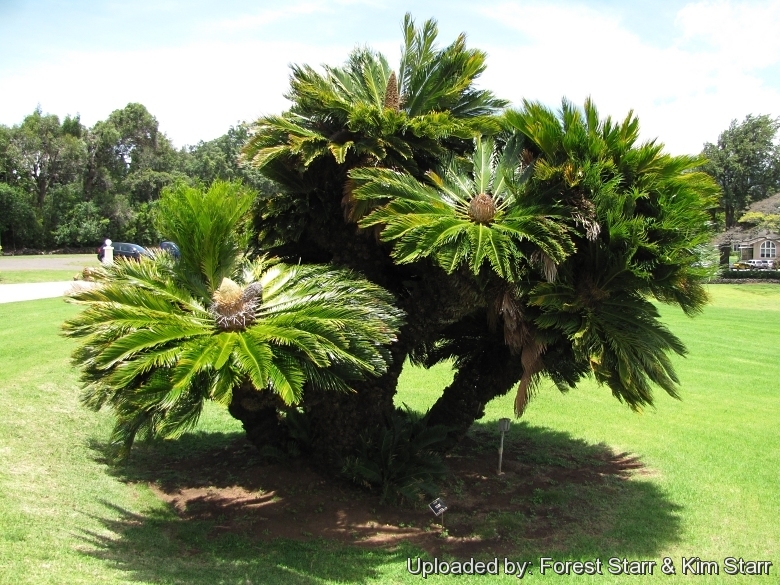
Cycas revoluta Photo by: Forest Starr & Kim Starr
Habit at Hui Noeau Makawao, Maui, Hawaii (USA). May 30, 2012.
Origin and Habitat: Endemic to Japan (Ryukyu and other islands off southern Kyushu,) and china Fujian (Lianjiang Xian, Ningde Xian, and some islands)
Altitude: 100 and 500 m
Habitat: Grows mainly on the sea shore in thickets on hillsides and in sparse forests. Rainfall is high with 2000-2200 mm per annum. Most of that falls in the late spring, summer, and autumn, particularly during the monsoon season. Autumn are drier and often sunny, but by December skies grow cloudy, rainfall drops considerably, and temperatures cool down.
Synonyms:
See all synonyms of Cycas revoluta
back
Accepted name in llifle Database:Cycas revoluta Thunb.Nova Acta Regiae Soc. Sci. Upsal. 4: 40 1783Synonymy: 8
back
Common Names include:
ENGLISH: Sago Palm, King Sago Palm, Sago Cycad, Cycad, Funeral Palm
BISLAMA (Bichelamar): Natanggura
CATALAN (Català): Ciques
CHINESE (中文): 琉球苏铁, 苏铁 (Su tie)
CZECH (Čeština): Cykas japonský
DANISH (Dansk): Sagopalme, Japansk Koglepalme
DUTCH (Nederlands): Smalbladige Sagopalm, Vredespalm, Cycaspalm
FINNISH (Suomi): Saagopalmu, Japaninkäpypalmu
FRENCH (Français): Sagou du Japon, Petit Rameau, Cycas du Japon, Cycas sagoutier
GEORGIAN (ქართული): ციკასი
GERMAN (Deutsch): Sagopalme
GREEK (Ελληνικά): Κύκας
HUNGARIAN (Magyar): Japán cikász
ITALIAN (Italiano): Cycas, Palma a sagù, Cycas revoluta
JAPANESE (日本語): ソテツ
KOREAN (한국어): 소철 (So ch'eol)
LITHUANIAN (Lietuvių): Paprastasis cikas
MALAYALAM (മലയാളം): അലങ്കാരപ്പന
MARATHI (मराठी): सॅगो पाम
NORWEGIAN (Bokmål): Sagopalme
PERSIAN (فارسی): (گلدان نقرهای (گیاه
POLISH ( Polski): Sagowiec odwinięty
PORTUGUESE (Português): Sagu-de-jardim
RUSSIAN (Русский): Цикас поникающий (Tsikas ponikaiushchii), Саговник поникающий (Sagovnik ponikaiushchii), Саговник поникающий древовидный Sagovnik ponikaiushchii drevovidnyi (trunk)
SPANISH (Español): Cicas revoluta, Palma sagú, Palma de Iglesia, Cica, Sagutero
TARANDINE (Tarandíne): Cycas revoluta
THAI (ภาษาไทย): สาคู, ปรงสาคู
UPPER SORBIAN (Hornjoserbsce): Japanski palmowy paproć
VIETNAMESE (Tiếng Việt): Vạn tuế
Description: Cycas revolutaSN|23433]]SN|23433]] is a low growing single trucked cycad, topped with whorled feathery leaves. Eventually, offsets begin to grow at the base of mature specimen, and occasionally in the crown producing multiple heads of leaves. The specific epithet “revoluta” refers to the the revolute (curled back) nature of the leaflets; the edges roll under the leaflet. Younger plants look like ferns with rosette of leaves coming from a stem near the ground. This is the most widely cultivated of the cycads.
Stem (trunk): Upright, rough and retaing the old leaf bases of previous leaves, about 20-25 cm across, and usually 1,5-3 m high, however older specimens may develop a trunk or up to 6 m tall.
Leaves: Long-lived, feather like growing in a circular pattern at top of trunk, 1-pinnately divided up to 90 cm long (or longer if not grown in full sun), leaflets narrow, with a sunken midrib and the margins rolled downward very dark glossy green or dark olive green, stiff and pointed, and about 10 cm long. The basal leaflets are gradually reduced to spines (whereas the similar Cycas circinalisSN|28817]]SN|28817]] does not have spines at the leaf base). It produce a periodic "flush" of new leaves, called a "break".
Flowers: Dioecious; reproductive clusters around frond bases.
Female inflorescense: The female cone is cabbage-shaped, gold or tan-yellow in colour borne on small whitish miniature feather like modified leaves called macrosporophylls. It will slowly open up when receptive to pollen and later forms a tightly packed seed head.
Male inflorescence (cones): Large and erect, pineapple shaped.
Blooming season: Females and male specimens produce "cones" in May when it is time to pollinate. Wind, bees, or other insects can pollinate the plants.
Seeds: Large, plum-like, pale yellow-tan to orange, about 3 cm across. Seed develop over the summer and are ready to be removed in January or February. A female plant cannot produce viable, fertile seed unless it is pollinated.
Remarks: Cycas revolutaSN|23433]]SN|23433]] usually known as the "Sago Palm" is actually related to conifer and Ginko trees and is one of the most primitive living seed plants (a living fossil). Cycads have changed very little in the last 200 million years. Fossils have been found on almost every continent on the planet. But most people don’t realize that it is not a palm at all.
Subspecies, varieties, forms and cultivars of plants belonging to the Cycas revoluta group
Bibliography: Major references and further lectures
1) Wikipedia contributors. "Cycas revoluta." Wikipedia, The Free Encyclopedia. Wikipedia, The Free Encyclopedia, 6 May. 2014. Web. 29 Jul. 2014.
2) Whitelock, Loran M. “The Cycads.” Timber press 2002
3) Hill, K.D. 2010. Cycas revoluta. The “IUCN Red List of Threatened Species”. Version 2014.2. <www.iucnredlist.org>. Downloaded on 29 July 2014.
4) Harrison, Lorraine . “RHS Latin for gardeners.” United Kingdom: Mitchell Beazley. 2012
5) Muller-Esneault, Susan "Cycas Revoluta: The Sago Palm, or Cycad Toxicity". Critterology.com. 2009
6) Wu Zhengyi, Peter H. Raven, Deyuan Hong (Hrsg.): "Flora of China. Volume 5: Ulmaceae through Basellaceae," Science Press/Missouri Botanical Garden Press, Beijing/St. Louis 2003
7)Jules Janick, Robert E. Paull “The Encyclopedia of Fruit and Nuts” CABI, 2008
9)Haynes J.L, “World List of Cycads: A Historical Review” IUCN/SSC Cycad Specialist Group, 2012
10) Forest & Kim Starr Cycas revoluta (Cycad, sago palm). Plants of Hawaii. <http://www.starrenvironmental.com>. Downloaded on 16 Sep. 2014.
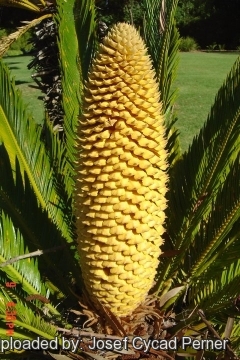 Male cone. Photo by: Josef Cycad Perner
Male cone. Photo by: Josef Cycad Perner Male cone and female megasporophylls at Enchanting Gardens of Kula, Maui, Hawaii (USA). July 16, 2008. Photo by: Forest Starr & Kim Starr
Male cone and female megasporophylls at Enchanting Gardens of Kula, Maui, Hawaii (USA). July 16, 2008. Photo by: Forest Starr & Kim Starr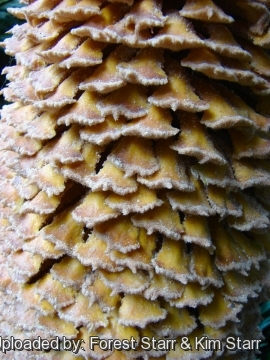 Male cone at Enchanting Gardens of Kula, Maui, Hawaii (USA). July 16, 2008. Photo by: Forest Starr & Kim Starr
Male cone at Enchanting Gardens of Kula, Maui, Hawaii (USA). July 16, 2008. Photo by: Forest Starr & Kim Starr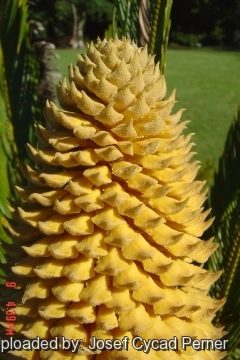 Microsporophylls. Photo by: Josef Cycad Perner
Microsporophylls. Photo by: Josef Cycad Perner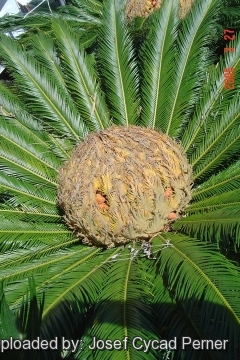 Megasporophylls with seeds. Photo by: Josef Cycad Perner
Megasporophylls with seeds. Photo by: Josef Cycad Perner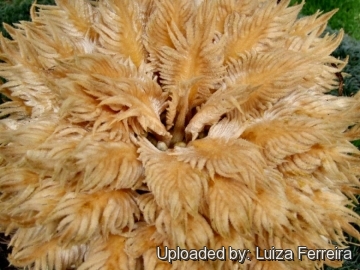 Female megasporophylls. Photo by: Luiza Ferreira
Female megasporophylls. Photo by: Luiza Ferreira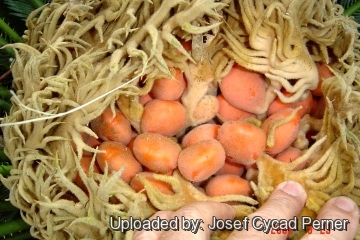 Seeds. Photo by: Josef Cycad Perner
Seeds. Photo by: Josef Cycad Perner Cycas revoluta Photo by: Raimondo Paladini
Cycas revoluta Photo by: Raimondo PaladiniCultivation and Propagation: It is easy to grow, tolerating dry periods, and light frosts. It prefers bright light exposure but colour bleaches when in full sun; best with some protection from afternoon heat. Needs a well drained spot, with deep soil, but will still thrive in less than ideal conditions, not tolerant of alkaline soils. Usually slow growing, however good conditions can speed it up considerably. Because of its growth habit, fertilize only when terminal bud begins to swell, indicating the start of the annual growth cycle.
Maintenance: Minimal; removal of offsets if desired, removal of spent fronds
Propagation: Seed or offshoots (or "pups" ). The advantage of the "pups" is that you will know its sex, for seedlings you will have to wait several years until the plant flowers to find out. After fertile seeds are collected, they usually need several months of storage before the inner embryo is ready to germinate. Therefore, it is best to clean the seeds of external fruit and set them aside before attempting to propagate the seeds.
Use: Landscape as cultivated perennial in warm, coastal areas; House-plant or interior-scape, as container plant in cool areas, as well very well suited to bonsai culture.
Warning: Best kept away from paths, since the leaves are quite stiff. The plants contain alkaloids of carcinogens and also an amino-acid that causes chronic nervous disorders. Regular consumption of the plant leads to severe health problems and death. Poisonous Parts: Fleshy seeds, leaves, unprocessed flour from stem pith. Symptoms: Vomiting, diarrhea, headache, dizziness, seizures.
Edibility: Processed flour, toxic if large quantities eaten.
Your Photos
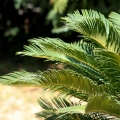
by Valentino Vallicelli

by Forest Starr & Kim Starr

by Forest Starr & Kim Starr
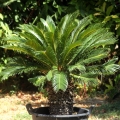
by Valentino Vallicelli

by Luiza Ferreira






















